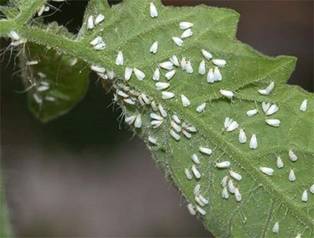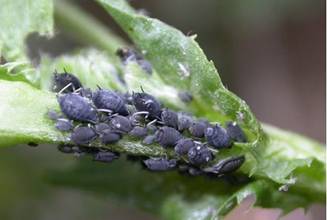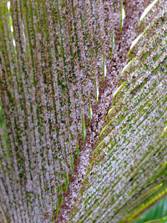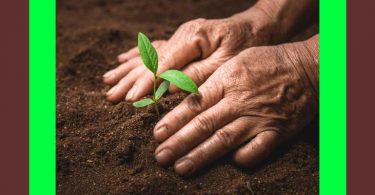This month, our plant doctors Radko Tichavshy, Mark Moodie and Pawan Singhania weigh in on your plant problems.
Radko Tichavsky is a Czech born Mexican Agrohomeopath. He is the former director of Instituto Comenius at Mexico, author of Handbook of Agrohomeopathy, 2007 (Spanish) and Homepathy for Plants, 2009 (Spanish) and creator and teacher of Holohomeopathy. www.icomenius.edu.mx El 04/12/2014, a las 15:36, Radko Tichavsky [email protected] escribió
Mark Moodie hosts the website Considera which provides a growing M.M and Repertory for plants and discusses resources for biodynamics and Agrohomeopathy The website allows the world community to contribute their experiences in planting

Hi Sir
I am from Kerala. In my vegetable garden most vegetable plants are infested with whitefly (tomato, bringal, green pepper) and the cowpea is infested with black aphids coming with ants. I am attaching two photos.

White Fly on tomato and green pepper

Black aphids on cowpea
Thank you
Abdul Salih
Radko Tichavsky:
Hi Salih. Black aphids in cowpea are usually a result of too much nitrogen application in the soil. Reduce the use of animal excrement (if used) and apply Carbo vegetabilis 6 CH and Azadirachta indica 6 CH (mixed with a little vegetable oil and water) once a week.
For the tomato whitefly in green pepper you can use Phosphorus 12 CH and Ocimum basilicum 6 CH and Urtica urens 6 CH.
Hi Plant Doctors,
We have several Sago Palms in our yard and several have a white scaly looking coating on the underside of the leaves (see photos below). This is an infestation from a small scale insect called Aulacaspis yasumatsu . It has become a regional problem in the southeastern U. S. where the region is hot and humid. This insect attacks the sago fronds by gathering on the underside of the leaves and does not infect other plants, just the Sago. I watered around the base with Sulphur 30C . After one week I do not see any improvement. Should I use a stronger potency or another remedy?
This is our winter season in Florida and temperatures have been in the low 40’s to low 60’s at night. High temps range from mid 50s to the mid 70s. It is humid but not nearly as bad as summer. The soil here is very sandy and I have noticed that many trees (citrus, fig, pecan, oak) suffer with varying diseases. We have experienced regular rains. This infestation has been going on for some months.
The prevailing treatment is to use an oil solution: 1 part horticulture oil to 100 parts water. This has been effective but the scale can remain even after treatment. The University of Florida says that the scale insect usually infests the roots to a depth of 60cm and can kill the plant.
Any thoughts would be greatly appreciated. I am also including a photo of a healthy sago tree.
Many thanks for your time and suggestions!
Hugh Holborn
Radko Tichavsky:
Hi Hugh. The Sulphur is contraindicated in the treatment of Aulacaspis yasumatsui in Sago palms (Cycas spp.). The palliative local application of oils and soaps is not very effective, because the pest is also rooted in the root system.
Homeopathic remedies used in the treatment of this disease in Cycas are mainly Phosphorus, Carbo vegetabilis, Acidum nitricum, Calcarea carbonica and Lycopodium, drugs whose common characteristic is the sensitivity to changes in temperature. The temperature in the Mesozoic, the native time of Cycas was much more stable compared with the current climate.
The plant remedies that may be used in this symptomatology in Cycas in the southeastern US are: Nephrolepis cordifolia, Nicotiana glauca, Casuarina equisetifolia and Origanum vulgaris. The constitutional remedies that are most common are Cycas revolut, Dioon angustifolium and Dioon spinulosorum.
The Cycadaceas plants are native to Asia and served in mesozeno as the main food of dinosaurs. After the cataclysm that wiped out the dinosaurs, many important companion plants of Cycads also disappeared. When imported as decorative plants from exotic habitats (eg Florida), the maladjustment to sudden temperature changes is strongly expressed by Aulacaspis sp., probably imported also from Asia. The lack of natural enemies in Florida, (thanks to applications of pesticides) present in their natural habitat makes the disease devastating. Thanks to human activity (tourism, application of pesticides and climate changes) today almost half of the Cycads from the planet are on the list of endangered plants.
Mark Moodie : Hello Hugh. See this discussion:
Perhaps there is an idea here for an isotherapeutic approach which seems to have had great success.
Put “scale” into the search box at Considera ) and you get
| All-c. | Allium Cepa |
| Coc-c. | Coccus Cacti |
| Thuja | Thuja Occidentalis |
| Ric | Ricinus Communis |
| BDM – KP | Kiwifruit Peppers |
| BiP – C2 | Biplantol contra x2 |
| Petroleum | Petroleum |
| Psorinum | Psorinum |
| Shellac | Shellac |
| Cuprum | Cuprum Metallicum |
| Silicea | Silicea |
| Sulph. | Sulphur |
Pawan Singhania: Hugh, I wonder if we can treat scale with Homeopathy. You can try Rhus Tox 200 and alternate with Variolinum 200, every 24 hours. This however, may not help in such a severely affected Sago. Your Sago seems to be infected with mealy bugs, not scale insects. Please confirm.
Greetings,
I have an indoor grapefruit tree that is almost eight years old. I watered it with a soil innoculant in water (EM1- for ‘efficient microbes’ ). It has just started to fruit for the first time. However, it is infested with scales, causing a sticky ‘honeydew’ on the leaves and black fungus on the leaves. Is there a homeopathic remedy that would repel these insects?
Thank you and God bless you,
Irma Powell
Radko Tichavsky : Hi Irma. A homeopathic remedy that can be used for this symptomatology in grapefruit is Sulphur 6 CH (do not apply when there is lots of sun), Echinacea 6 CH, Silicea terra 12 CH ( for this only one application). Avoid spraying the leaves of the plant with the water and perform irrigation only on the trunk of the plant. The nitrogen supply to the plant must be reduced slightly since this increases the problem. The symptoms decrease under the influence of sun, so it is important to seek greater exposure to the sun when possible.
Mark Moodie : Hello Irma. See the discussion at this link
Pawan Singhania:
Dear Irma,
Homeopathic remedies cannot repel any insects. They can instead possibly increase the immune system of the tree. But, which remedy can do that is something to be understood. I would suggest that you undertake soil management practices by incorporating well digested aerobically fermented compost, at least three applications in a year (mixing it within the soil) and allowing the aerobic microbes to flourish. When the soil has a good population of aerobic microbes, they in turn make things available to plants or trees, which makes the plants or trees healthy. This usually improves their immune system. However, any infection is a sign of lack of immunity and health, hence, the infection.
In the present circumstances, it appears that the tree is infected with aphids. Please also check if you see any ants running up and down. If so, you may try the following recipe: 100 gms of garlic cloves, 0.5 liters of water, 10 gm soap, 2 teaspoons mineral oil. Steep finely grated garlic for 24 hours in the mineral oil. Dissolve the soap in water, mix with the infusion of garlic and mineral oil, stir well together and filter through a fine cloth. Before use this solution is diluted with 20 parts of water.
Hi Doctors,
I am in Pune, India. My Pomegranate plant has grown well, but the fruit buds fall off as it starts to flower. They are not firm and strong. Can you advise some treatment?
Thank you
Aspy Billiardmaker
Radko Tichavsky : Hi Aspy. Apply Ferrum suphuricum 6 CH and pine leaves and scatter them around your plant in the soil to acidify the soil a bit. In Pune, India there are very alkaline soils (pH 8.2-8.5) and pomegranate does not support much alkalinity, which stress is expressed with falling flowers.
Mark: Hello Aspy. Searching here: gives the following
| Calcarea | Calcarea Carbonica |
| Cantharis | Cantharis |
| Cuprum | Cuprum Metallicum |
| Ferrum | Ferrum Metallicum |
| Kali-c. | Kali Carbonicum |
| Kali-s. | Kali Sulphuricum |
| Lap-a. | Lapis Albus |
| Mag-p. | Magnesia Phosphorica |
| Secale | Secale Cornutum |
| Tanac. | Tanacetum Vulgare |
| Vib. | Viburnum Opulus |
| BD500 | 500 |
| BD501 | 501 |
| Thuja | Thuja Occidentalis |
| Carb-v. | Carbo Vegetabilis |
| Natrum mur. | Natrum Muriaticum |
| BD – Fla | Barrel compost / Fladen |
| Hel | Helix Tosta |
| BDM – PM | PhotoMax or PM |
| BD507 | 507 |
| Silicea | Silicea |
| Arsenicum | Arsenicum Album |
| BD508 | 508 |
| Arv | Arvicolinae (rodents) |
| Pip-m. | Piper Methysticum |
Respected sir,
I am glad to know that you are helping people who are living on cultivation (gardening). I have a mango garden that relies on rain. I use N.P.K foliar spray (10g/1lt ). My garden is 36 years old. Can you suggest how to cope with water scarcity, and how to increase the fruit size once its sets? Is there a substitute for chemical fertilizers with homeopathy?
Chittoor district is one of the chronically drought affected Rayalasema districts of Andhra, Pradesh. It covers a geographical area of 15,152 sq. km and situated between 12° 37’ and 14°00’ North latitudes and 78°03’ and 79°55’ Eastern longitudes.
Farmers are mostly dependent on ground water for their irrigation purposes. The district receives moderate rainfall. Failure of monsoons during the last few years lead to failure of bore wells and failure of crops.
Normal annual rainfall total 934 mm
Southwest monsoon
Northeast monsoon 438 mm 47%
Cumulative departure from 396 mm 42%
Normal rainfall for the last 5 years -61%
Thank you,
Suresh Babu – Andhra Pradesh
Radko Tichavsky: Hello Suresh. To retain moisture in dry seasons it is important to maintain a high content of organic matter in the soil. With 5% organic matter in the soil and deep soil without any rain for even three years, crops still grow nicely. But a soil devoid of organic matter and addicted to artificial fertilizers is an easy victim of drought and imbalances. I suggest you prepare a broth made of 5 kg of Opuntia ficus-indica liquefied and diluted in 200/ l of water. This liquid has to be diluted in 1:20 ratio and applied on the soil.
We use the Opuntia ficus-indica in very dry areas to increase water retention in the soil. But most important is to start a compost production program and adding large amounts of organic matter to the soil. Nourish your soil well and it will take care to nurture of your trees, and they will express their vitality by well-shaped fruits of good size and excellent nutritional content. Instead of foliar application of NPK you could do tea-compost application (aqueous extract of the compost) that will add to the tree the macronutrients (NPK) but also lot of micronutrients, in addition to humic and fulvic acids and other organic beneficial compounds. Once you balance the vitality of the soil and plants with these best-practices, you can begin applying agrohomeopathy, an excellent promoter of vitality in the soil, plants and human resource.
Mark Moodie :
Hello Suresh,
This is a difficult situation and what can and often must be done is usually more physical agricultural activity with which I am sure you are familiar: mulching, soil building, shade, etc. However, there is some work on dealing with drought and you can find a report here:
https://www.dropbox.com/s/uo9fikz8chq0k6r/DroughtPeppers.pdf?dl=0
Pawan Singhania: Dear Suresh,
Homeopathic remedies are not nutrients, therefore, are not any substitute for fertilizers. The remedies act particularly through stimulating the immune system (vital force) of the organisms, i.e. plants, animals or human beings. You have in fact addressed three issues; nutrition, water and size/quality of mangoes. The followings suggestions may help.
Fertilization by foliar feed of NPK: While foliar feed is one option, it is not a substitute to root absorption. Hence, you must try to improve upon the soil nutrition. Considering the draught situation, you would benefit better if you adopted some cultivation (or inter-culture) operations that would improve the soil’s microbial counts and the active humus content. That would improve the soil’s water holding capacity and counteract the lack of water to some extent. As your garden is 36 years old, I am sure the mango roots have penetrated to a depth where you cannot reach and in fact the trees are now surviving on natural components of the soil.
I suggest the followings:
- Use Compost: Make aerobic compost (preferably using the Biodynamic preparations), made of garden waste like leaves, grass, cow dung, etc. inoculated with the BD preparations. Incorporate this compost three times in a year @ 2 MT/ acre/year. Put this in split doses of 50% at onset of summer, 30% at onset of monsoon and 20% beginning of winter.
- Mulch or Grow Cover Crops: Spread a layer of mulch during summer, or better still find any suitable gram or lentil or green grass or even piper menthysticum (pudina or peppermint plants) to grow as ground cover or even clover. Mix this up with the soil at the onset of monsoon and grow another local green crop during monsoon. Always try to cover the soil preferably by growing some cover crop and finally either making a compost of them or incorporating within the soil. Over a period of three years, the soil will improve, demanding less water but improving the health of the soil, which will also improve the size and quality of the mangoes. The increase in the soil’s microbial counts and production of mild acids by this practice will dissolve the soil minerals and meet the NPK and other nutritional demands. You may enrich your compost with single super phosphate, calcium carbonate. As the soil fertility will improve, it will improve the crop quality and size.
- Biodynamic Agriculture Practices : Try to learn the BD Agriculture Practices, and apply the Sequential Sprays with BD preparations to trigger the watery element over your field. The meticulous application of certain BD Sequential sprays may attract some rain clouds, if not will atleast increase the water content of the atmosphere and the watery element within the trees, besides, fighting the drought condition and improving the immune system of the trees. This is something I cannot explain to you on these pages. First you learn about the subject and then later I can help you when you are a little bit advanced.








Greetings Mark, Radko, and Pawan,
Thank you for your considerable input into my Sago Palm disease. I will begin experimenting and attempt to find a remedy that produces positive results. As those results develop I will most certainly report back to you.
Mark, I have been using the search feature at considera.org and enjoy reading up on all of the return queries. Thanks for making this feature available to everyone!
I am further intrigued with Radko’s ideas on constitutional remedies for plants. Unfortunately, the research necessary to identify the secondary metabolites and cross check by plant the substances involved may be greater than my time and abilities allow. My question: Is there a source that might list the identified constitutional remedies for plants. Any help along this line would be great!
Last month Radko suggested Traraxicum for the Pomegranate tree in my yard. It has proven to be very cold in north Florida this month but am planning to apply Taraxicum and will keep you posted.
Thanks once again for your time and suggestions I really appreciate your efforts.
Sincere regards,
Hugh
Dear Hugh,
I am engineer and not a specialist for soils, plants etc. but I test each plant. I work like my brilliant homeopath, he does distance healing, mental healing etc. Since April 2014 I work with plants. My experiences show that plants often need Lacs, metals and even nosodes. Banana plants for example mostly need Merc. The symptoms are here brown dry parts with a yellow edge (destroying) on the leaves. I often use Mag. met., too. Horse chestnust trees I treat usually first with Au, then mag. met. and often with a metal from the Ferrum-series. I use all potencies from D30, C, LM, Q and M and combine them if neccessary. My Website under construction is only available in German, sorry.
I hope, I could help you. Greetings from Germany
I have a question about planting azaleas. I have two plants and I want to plant them in large pots instead of in the ground. I live in Michigan. Will these plants flower if i plant in pots instead of ground?